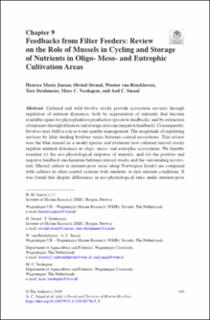| dc.description.abstract | Cultured and wild bivalve stocks provide ecosystem services through regulation of nutrient dynamics; both by regeneration of nutrients that become available again for phytoplankton production (positive feedback), and by extraction of nutrients through filtration and storage in tissue (negative feedback). Consequently, bivalves may fulfil a role in water quality management. The magnitude of regulating services by filter feeding bivalves varies between coastal ecosystems. This review uses the blue mussel as a model species and evaluates how cultured mussel stocks regulate nutrient dynamics in oligo- meso- and eutrophic ecosystems. We thereby examine (i) the eco-physiological response of mussels, and (ii) the positive and negative feedback mechanisms between mussel stocks and the surrounding ecosystem. Mussel culture in nutrient-poor areas (deep Norwegian fjords) are compared with cultures in other coastal systems with medium- to rich nutrient conditions. It was found that despite differences in eco-physiological rates under nutrient-poor conditions (higher clearance, lower egestion, similar excretion and tissue storage rates), the proportion of nutrients regenerated was similar between (deep) nutrient-poor and (shallow) nutrient-rich areas. Of the filtered nutrients, 40–50% is regenerated and thus made available again for phytoplankton growth, and 10–50% of the filtered nutrients is stored in tissue and could be removed from the system by harvest. A priori, we inferred that as a consequence of low background nutrient levels, mussels would potentially have a larger effect on ecosystem functioning in nutrient-poor systems and/or seasons. However, this review showed that due to the physical characteristics (volume, water residence time) and low mussel densities in nutrient-poor Norwegian fjord systems, the effects were lower for these sites, while estimates were more profound in shallow nutrient-rich areas with more intensive aquaculture activities, especially in terms of the negative feedback mechanisms (filtration intensity). | en_US |
